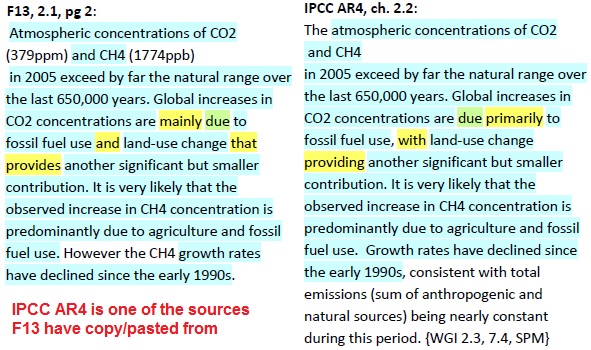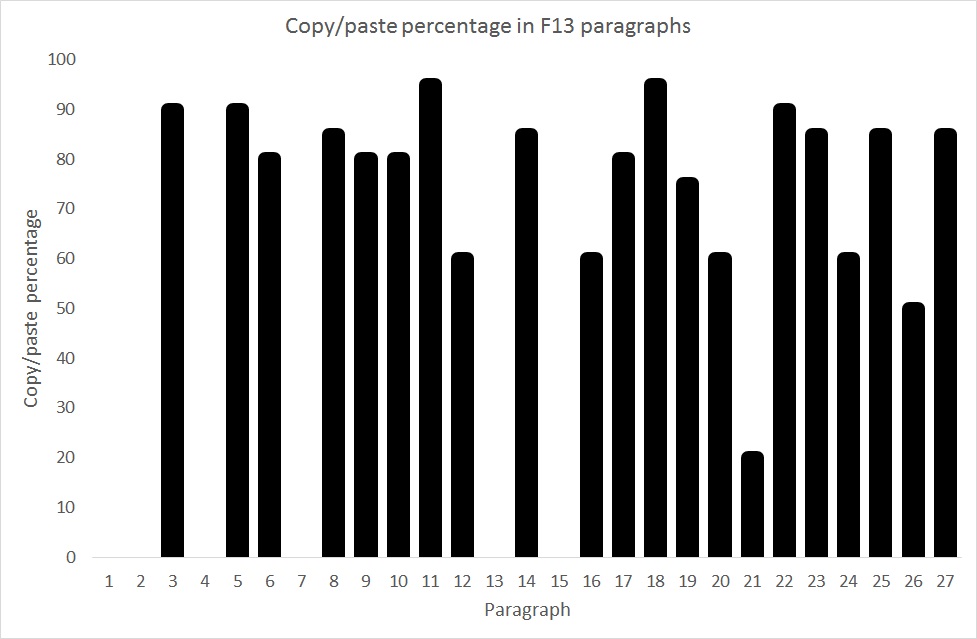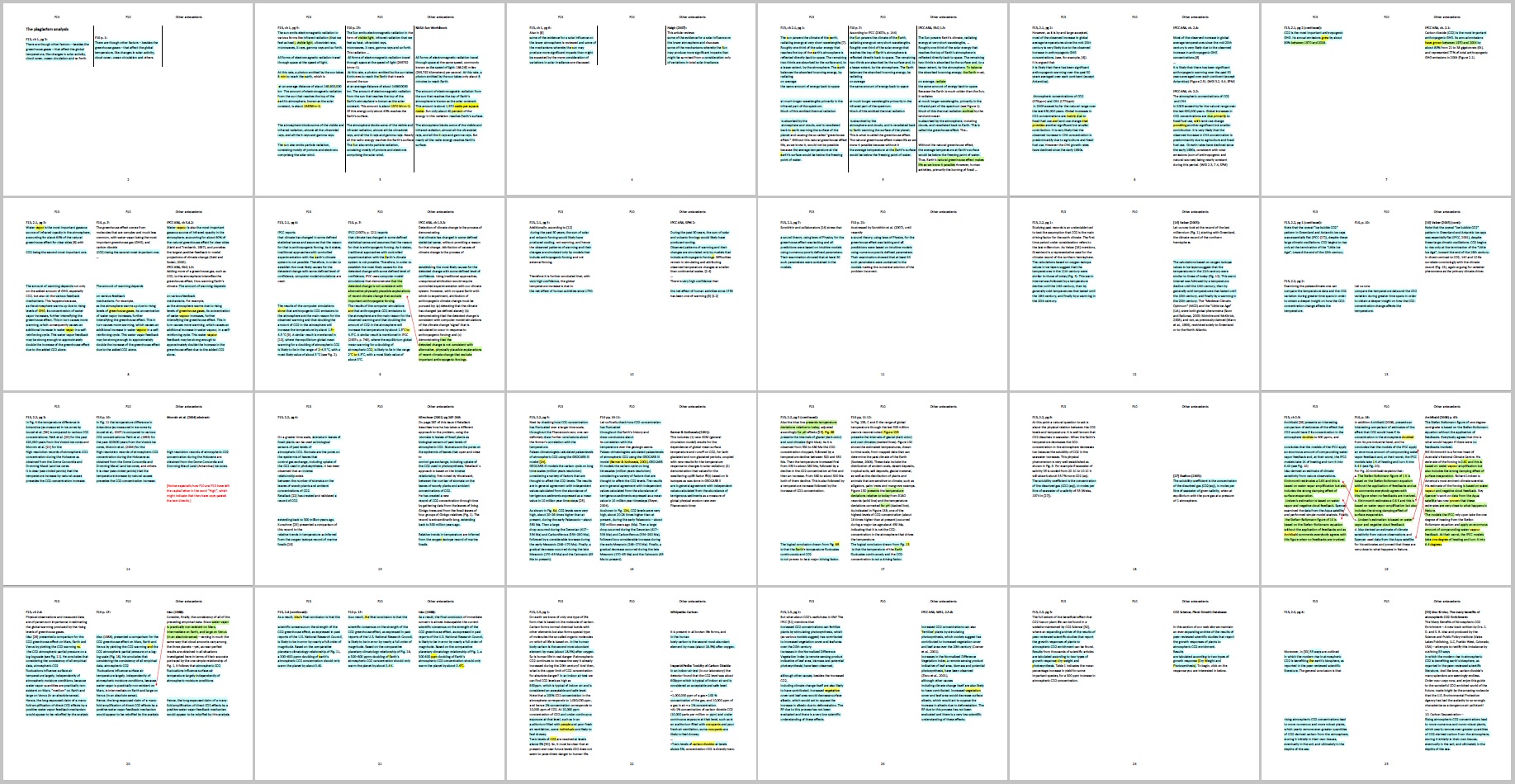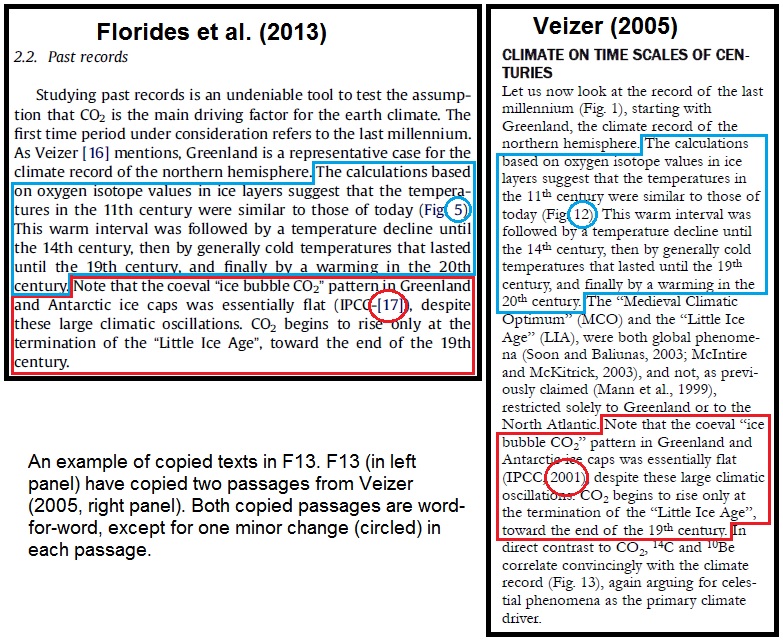The F13 files, part 1 - the copy/paste job
Posted on 17 October 2017 by Ari Jokimäki
Elsevier's journal Renewable and Sustainable Energy Reviews published a paper in 2013 (Florides et al. 2013, "F13" from now on) which we found problematic. We analysed the paper and communicated our findings to Elsevier. Our main findings were that much of F13 text was copy/pasted from other sources without proper attribution and that F13 contained many false claims. In this series of posts I'll go through the problems in F13 and in Elsevier actions. There are four posts:
- The F13 files, part 1 - the copy/paste job
- The F13 files, part 2 - the content analysis
- The F13 files, part 3 - the reference list analysis and other problems
- The F13 files, part 4 - dealing with Elsevier
Part 1 - the copy/paste job
About three years ago we contacted Elsevier to inform them that a paper they had published, the F13, was problematic in many ways. F13 is written as a review article on the climatic effects of carbon dioxide and the Sun, but it really is yet another attempt to publish climate myths within scientific literature. I'll go through the problems with the contents in the subsequent posts, but here I would like to highlight another apparent problem in F13.

When we, the Skeptical Science volunteer community, first became aware of this paper, we started to check it out. As I was checking one of the F13 references to see what it says on one of the claims of F13, I noticed that the reference had some text that was exactly the same as the text in F13. Only thing missing was quotation marks in F13 to indicate that they had quoted the text directly from their reference (they did give the reference). I then decided to check another passage elsewhere from F13. I found the same thing. The text was copied without indicating that it was quoted. I dug some more and kept finding copy/pasted passages.
We discussed the situation among SkS volunteers, and I started to go through F13 thoroughly for copy/pasted passages. I ended up doing that to first two chapters of F13, and with help from John Mashey (who had been involved with the similar issue with Wegman et al.), we wrote an analysis of the copy/paste issue for Elsevier. I'll go through the dealings with Elsevier in a subsequent post, but here I'll give some details on the copy/pasted passages.
Overview of the copy/pasted content
There are 27 paragraphs in the two chapters we analyzed. We didn't find obviously copied passages from six of the paragraphs, so 78% of paragraphs contain copy/pasted passages. I also estimated the percentage of copied text within each paragraph. The average of these percentages is 59%, so on average F13 paragraphs seem to contain about 60% of copied texts. None of the paragraphs were copied fully, but there always was at least a word or two changed from the original text. The edits were trivial enough to suggest that there were deliberate copy-paste-editing involved. The graph below shows the copy/paste percentages for each paragraph we analyzed.
F13 main source for the copied texts is their book chapter from 2010 but the book chapter has also copied text from other sources, so some of the copied passages in F13 come from other sources but through their book chapter. Another main source for copied texts in F13 is IPCC AR4, which they copy both directly and through their book chapter. Other sources are from the scientific literature, books, blogs, and even Wikipedia.
The image below shows our analysis to give readers further idea of the extent and structure of copy/pasted contents in F13 (PDF file of the analysis is available). Each small panel contains one page of our analysis. In each panel, the left column shows the F13 text, center column shows the Florides et al. book chapter mentioned above, and the right column shows other references they have copied from. Highlight colors are: blue = text has been copied word-for-word and in order, green = text has been copied word-for-word in rearranged order, yellow = trivial changes within copied texts, and no highlight color = no obvious copy/pasted passages were found.
As can be seen from the image, general main color for left side columns is blue and non-highlighted passages are quite rare. However, it should be noted that the six paragraphs we didn't find evidence for copy/pasted passages are not shown in this image.
(Click the image for bigger version.)
Examples of copy/pasted passages
(Click the image for bigger version.)
In the left panel of the image above, the F13 paragraph is shown in which I first noticed this copy/paste issue. The right panel shows a paragraph from Veizer (2005). Highlighted with blue and red frames are the directly copy pasted passages with minor changes circled.
The image below shows an example of how F13 have copied from their own book chapter in which they have originally copy/pasted texts from other sources.
(Click the image for bigger version.)
The last example below shows evidence that these indeed are copy/pasted passages. They have copied a passage from Monnin et al. (2004) to their 2010 book chapter and from there to F13. The passage has been inserted to the middle of one of their sentences, but as it is a whole sentence in Monnin et al., it starts with capital letter. Unfortunately, they forgot to change it so they now have the word "high" with capital first letter in the middle of their sentence. Or, maybe they just wanted to Highlight it.
(Click the image for bigger version.)
Conclusions of the copy/pasted content
We found that most of the texts within the two chapters we analysed had been copy/pasted from other sources with trivial word changes here and there. Of the analysed 27 paragraphs 21 were found to contain copy/pasted content with half of the paragraphs being almost completely copy/pasted (copy/paste content over 80%). Among the sources were IPCC AR4, Wikipedia, some journal articles, and a book chapter written by F13 which had originally copied some of the contents from other sources. In the light of these findings it seems safe to say that F13 doesn't seem to be an original piece of work, but instead seems to have been stitched together by copy/pasting from other people's work, without acknowledgement.
Additional information
The full analysis of copy/pasted content.
References
Florides G., Christodoulides P., Messaritis V. (2010), Global warming: CO2 vs sun. In: Harris, Stuart Arthur, editor. Global warming, Sciyo, ISBN 978-953-307-149-7.
Georgios A. Florides, Paul Christodoulides, Vassilios Messaritis (2013, "F13"), Reviewing the effect of CO2 and the sun on global climate, Renewable and Sustainable Energy Reviews, Volume 26, October 2013, Pages 639-651, ISSN 1364-0321, http://dx.doi.org/10.1016/j.rser.2013.05.062.
Veizer, Ján (2005). Celestial Climate Driver: A Perspective from Four Billion Years of the Carbon Cycle. Geoscience Canada, [S.l.], mar. 2005. ISSN 1911-4850.
Eric Monnin, Eric J Steig, Urs Siegenthaler, Kenji Kawamura, Jakob Schwander, Bernhard Stauffer, Thomas F Stocker, David L Morse, Jean-Marc Barnola, Blandine Bellier, Dominique Raynaud, Hubertus Fischer (2004), Evidence for substantial accumulation rate variability in Antarctica during the Holocene, through synchronization of CO2 in the Taylor Dome, Dome C and DML ice cores, Earth and Planetary Science Letters, Volume 224, Issues 1–2, 30 July 2004, Pages 45-54, ISSN 0012-821X, http://dx.doi.org/10.1016/j.epsl.2004.05.007.































 Arguments
Arguments



































Great detective work. Plagiarising would get your university essay failed.
The consistent changing of just a few words sure looks like it might be an organised and deliberate pattern. For whatever reason I "couldnt possibly say".
The abstract of the F13 paper does indeed look like an excuse to sneak various myths into a so called research paper. It looks like a tasty gish gallop of debunked things to cause as much doubt as possible by careful word choice and subtle implication. Its not healthy upfront science, its a form of word play and unspoken communication by hitting hot buttons in the intended audience.
I don't know on what basis they would say Greenland is representative of the entire northern hemisphere. Looks like an empty assertion, unless they explain better somewhere else. I know this jumps the gun away from the copy and paste issue, but it jumped out and I will forget if I don't mention it now.
I also don't understand their ideas about global warming being related to partial pressure of gases in some sort of bicycle pump affect. Its true P/T = C for a given body of gas, even I remember stuff from chemistry class a million years ago, but nobody has been able to show where this additional pressure is coming from, to cause an actual increase in temperature. I certainly dont see any evidence from quantities of added gases, or changes in flow of masses of air bodies. Smells like pseudoscience to me.
I look forward to your in depth look at this side of things.
What nigelj said about plagiarism.
As for the bit about partial pressures affecting warming - it is probably part of the Sky-Dragon-class physics that says the whole atmospheric temperature profile is due to pressure heating (or something like that - I can't do justice to an idea that is that far from reality). There is a recent post on the subject over at And Then There's Physics.
Out of curiosity, what are the advantages and disadvantages to writing a rebuttal paper when shoddy science is used in the denier literature? I realize this is a slightly different case since it involves plagarism, but I hope you all don't mind because it is something I've wondered for awhile.
Derek, your question may be a little premature. Let's see more on the details of that paper. Valid "denier literature" is rarer than rocking-horse poo. But anything which shows even a degree of verisimilitude, is like a sticking-up nail that ought to be hammered down. (Unless the "literature" appears in Shonksville extremist publications like Journal of American Physicians & Surgeons ~ where Richard Lindzen has published [more a rant than a paper]).
I keenly look forward to Ari Jokimaki's next instalment.
(My apologies, Ari — for I haven't discovered how to correctly make the umlaut in your surname. )
Derek:
Scientific journals are rarely interested in papers that just point out errors in other papers. You will occasionally see "Comment on..." short contributions, but not often.
Scientists also don't get much credit for publishing such critiques - career advancement is based on new research, not pointing out that junk was published that ignored vast quantities of old research and got many basic things wrong.
...but it does happen. Read this RealClimate post from a couple of years ago that tells the sorty of publishing such a paper.
Let's Learn From Mistakes
I really like the "pressure heating" theory. As I recall, it says that heating is due to the effect of gravity on the atmosphere — i.e., "the sky is falling". They accuse climate "alarmists" of being Chicken Licken saying that the sky is falling, and I was tickled pink to see some deniers actually claiming that heating is literally because the sky is falling.
(Please correct me if I'm wrong.)
I forgot to mention: in many universities, plagiarism is grounds for explusion, not just failing.
Eclectic @4 - you can already read the other three articles which are linked from this one. They just don't yet show up on the homepage, but will in due course.
BaerbelW @8 , thank you for that !
How embarrassing. I saw: October 17th, Part 1 of a series . . . etc etc
I must remember that the pretty blue text can be clicked on !
Please excuse my Kopffurz (if that's the correct word for my idiocy).
I shall get reading.
Thanks @4 Eclectic and @5 Bob. Eclectic, I was actually referring to a paper I read where a geographer suggested an increase in seismicity at a mid-ocean ridge meant that there was increased heat flow into the oceans, which was in turn causing the oceans and atmosphere to warm. I'm a seismologist, and the seismology part of the paper seemed pretty poorly done. But as the link Bob posted shows, maybe this is not the best use of my time--probably better to be teaching my students how to be better critical thinkers!
Derek @10 , yes , thanks , and your point is an important one about cost-effective use of that finite resource [time]. And it very likely is correct that your own time is better spent in "raising" the younger cohorts to be more resistant to the BS which is swallowed by that substantial minority of oldies we know as Denialists — and more resistant through better critical thinking as well as through greater insight into their own tendencies toward motivated reasoning (etc).
Still, there are millions of scientific-minded citizens — and with a great diversity of interests . . . so it is not unreasonable for some percentage of them to give part of their time to "wrestle with the alligators" right now, while teachers such as yourself tackle the longer term plan of "swamp-drainage". [Please excuse the currently over-used analogy!] So I fully support Ari Jokimaki & his colleagues in their actions here.
On a side-note, being your mention of Global Warming from mid-ocean ridge warming : I must say that even I as a non-seismologist, can see that that particular argument has more holes in it than does Swiss cheese. Yet the Denialists will grasp at every straw they can see, despite all those straws being mutually contradictory.
And on the pressure-temperature thing, I have a salient memory (from my childhood) of my grandfather's extensive library containing a science book [copyrighted 1893, if I recall properly] which declared that the scientists had calculated that the Sun's output of heat was produced by the mechanism of gravitational collapse. The scientists opined that the Sun's diameter was shrinking by around 200 feet per year. (And as has been mentioned elsewhere, the discrepancy with terrestrial geology was not addressed.)
MODERATORS : I am wondering if you would consider merging the comments columns for The F13 files Parts 1-4 . There may be enough commonality & overlap, to justify having all comments in a single thread.
Derek:
Geothermal heat flow is, on average, pretty small. It is tiny compared to the radiative forcing from added CO2. To quote this Wikipedia page:
To contribute to global warming, you would have to have a significant increase in this quantity - like 10x more globally-averaged, which means probably 1000s time more in local areas. It ain't happening.
[I would try to defend classifying "geographers", as that is my background, buit "geographer" varies an awful lot and some of them are awfully ignorant on climate - such as TIm Ball.]
Derek, I live in New Zealand, right on a techtonic plate boundary, with significant volcanic and geothermal activity. Plus we recently had a big earthquake in Christchurch (but dont panic, very nice place overall).
Global warming is about 1 degree so in the middle of the range. We get a lot of electricity from geothermal energy, and theres no evidence of increasing trend of geothermal and / or volcanic activity that I'm aware of over the last 150 years.
Of course one country and anecdotal, but you have to start somewhere and its interesting.The whole idea that geothermal or undersea volcanic activity is driving climate change is invalid, because its contribution to warming is small, and theres no evidence of increases globally over the last century as a trend, and its hard to see why there would be. I also did some physical geography at university, so take an interest in what the earths crust is getting up to.
The oceans are warming, top-down. If increased heat flow into the oceans from subaerial volcanoes were the cause, we'd expect to not only see warming more botton-up, but we'd have to invent a whole new branch of physics to explain why rising concentrations of atmospheric CO2 aren't warming the oceans.
Per Cheng et al 2017:
And:
Larger image HERE.
Sadly, bad papers are common, and getting them retracted is almost impossible. Some journals (read: Editors) react quickly to concerns, others just don't care or are too busy.
Now, I note that in part 4 it is stated "He told us that they had checked the issue with "iThenticate", which didn't show high similarity. This means that they took F13 and their earlier book chapter and compared them to each other". I don't think the second sentence follows from the first. iThenticate checks all sources that it can access. Sometimes it does take some extra steps when a paper is already published to find the plagiarism, as it may primarily highlight the same paper as the source. You then need to actively deselect that source. So, maybe the EiC just didn't do that.
I also don't think Elsevier can be blamed so much, here. It looks like it is primarily the EiC who did everything he could to evade the issue. Having had my own contact with an Elsevier representative regarding >1000 fundamentally flawed papers (that's not a typo: more than 1000) in another field, I am somewhat sympathetic to their view that the Publisher should be very hesitant in meddling with the science that they publish. This is what the Editorial Boards are for. They may make more of an issue out of the plagiarism, so you should perhaps send the plagiarism overview to the Elsevier executive, and complain that the EiC does not take any action.
Marco, thank you for the correction regarding the iThenticate. I have corrected the relevant section of part 4.
I don't think I would describe the actions of the Editor-in-Chief as trying to evade the issue. I think he handled the issue sloppily, but I haven't seen any evidence that would suggest that he was deliberately trying to evade the issue.
As was noted in the part 4, we did send our plagiarism analysis also to the executive publisher of the journal.
Having a far less academic inclination than Ari Jokimaki, I am more offended by Florides's gross errors in the content of the F13 paper. Though I appreciate that the plagiarism aspect is an easier point of attack when approaching Elsevier.
Ari will be well aware that Florides had published some similar errors in 2009 and 2010 (possibly without the high level of plagiarism).
Question: What is an engineer (or three) in Cyprus up to, when he repeatedly publishes statements of very bad science? [i.e. in an area apparently outside his field of expertise]. Why the repeated gross errors? Not to mention Florides's refusal to properly engage with criticism, plus his refusal to make corrections.
It seems hard to go past the conclusion that Florides is simply a zealous crackpot on the subject of climate science. A denialist who wishes to publish as well as exist as a science-denier.
When I put on my Ten-Gallon Hat of Suspicion, I wonder whether the large amount of plagiarism in F13 might also point to the presence of a ghost-writer [a hack ghost-writer] supplying the bulk of the draft of the F13 paper (with final touches done by Florides et alia).
Is it known whether Heartland (or similar propaganda machines) provides a ghost-writing service for amenable denialists, in order to sprinkle the scientific literature with a few handfuls of "contrarian" papers?
from part 3: "Cook et al (2013) [2] found that only 0.7% of their sample rejected AGW, so F13 references them 50 times more than one would expect of an unbiased sample." That's clear evidence of bias. How does a 'review article' get away with such egregious cherry picking? And the mention, much less discussion, of 'cosmic rays'? What is such speculative 'research' even doing in a review of established climate science?
The F13 abstract lead off with: "This paper... suggests that numerical models that lack adequate knowledge of fundamental... factors cannot be used to extract “sound” conclusions." So, after extensive review, the authors conclude that 'Garbage in = Garbage out'? Brilliant (/s). Look, nobody makes a policy decision without a prediction of its outcome, based on a model of the future. That includes the 'do nothing' alternative. Trump etal have a model of future climate. Its probably just an 'it'll be alright, it's always been in the Past' model put in their heads by Fox News, but its still a model, and all models are wrong (the future cannot be perfectly predicted). The purpose of research is to make newer predictive models 'less wrong' than others. This implies that model comparison's are necessary to the process of continuous improvement. So, where are the denier models? Big fossils makes a trillion dollars in pure profit annually: where are its competing climate models? Where is Florides model? On what basis is Trump taking the 'do nothing' alternative? If you refuse to make something better than the moon, then you are stuck howling at the moon, which explains Florides first sentence, which reaches a conclusion any freshman studying 'C++' is taught in the first week of instruction.
Florides abstract: "science does not really have a complete... understanding of the factors affecting the earth's complex climate system and therefore no sound conclusions can be drawn." It doesn't matter for two reasons: 1) Policy must be made anyway. To make rational decisions requires the best predictive tools we have, regardless of our incomplete state of knowledge. 2) There is no such thing as a 'sound conclusion'. I'm reminded that, deciding how many Americans to send into Iwo Jima, planners developed a differential equation which assumed each Japanese would fight to the death. Was it accurate? Of course not. It was simply the best planning tool they had, so they used it. The calculation that doubling CO2 in the atmosphere will raise Earth's temperature by 4 C predates computer modelling by 75 years. Policy should be made on that basis, and not on the shifting goalposts of a denier like Florides, for whom scientific modelling will never be good enough because, happily for him, he doesn't have to front a competing model but gets paid apparently to be a professional critic.
Well done on your research of this paper and your efforts to hold the journal/authors to account.
One approach that you could try is to write a letter describing what has transpired to other journals to see if they might be interested in publishing your current critique paper. If they think the error are bad enough there’s a chance they would enjoy slinging some mud at Elsevier and publish your paper. However, sadly I think that this has only a smaller chance of success.
It is most likely that the Elsevier editor may have been right in suggesting the only way to move forward is a more general article critiquing this and other papers. Trying to publish an article that focuses on a critique of a single article is hard in science. The reason is that unless the errors are egregious, scientists try to avoid head on criticism of other scientists work and would rather focus on the science than the work of the researchers.